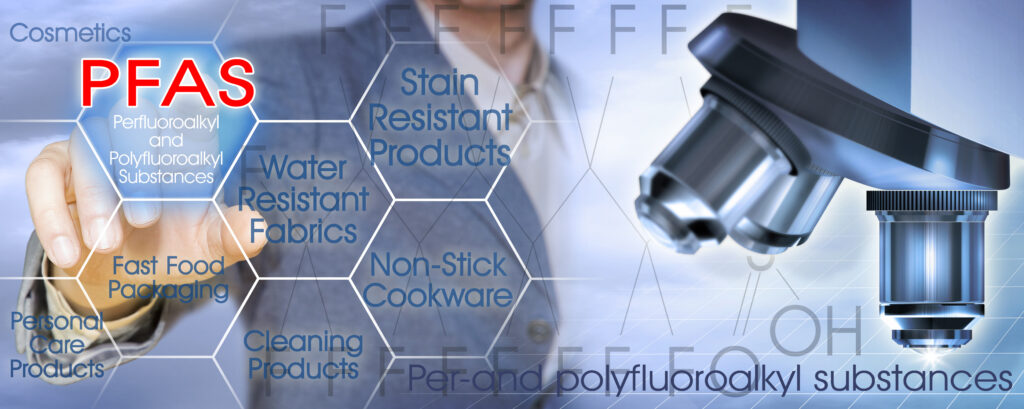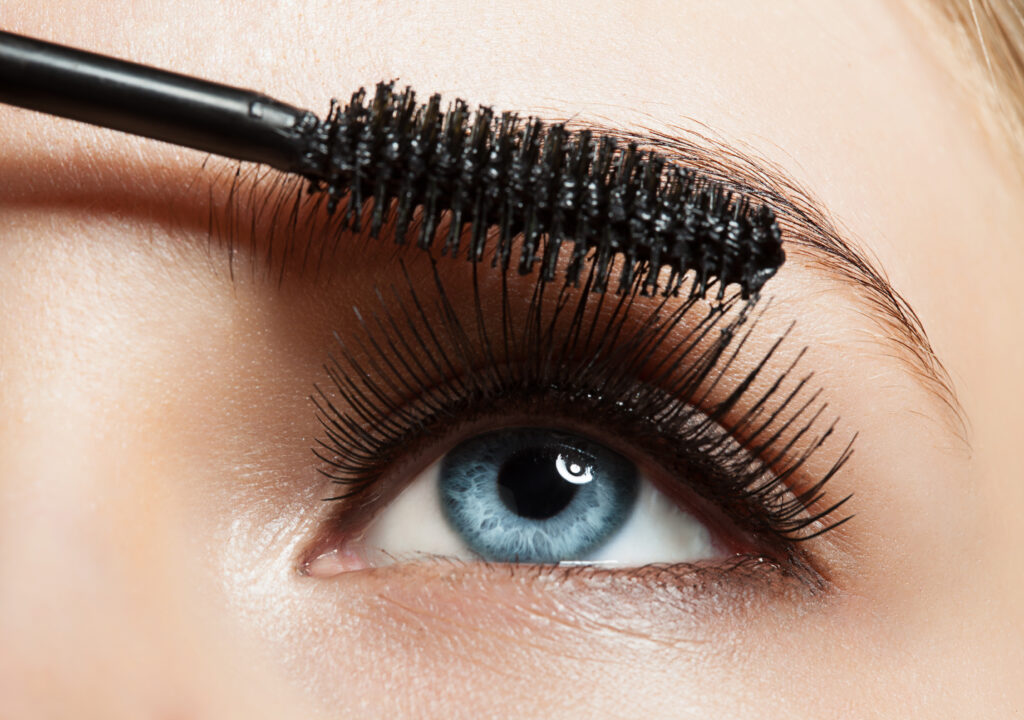Halt PFAS Exposure – PFAS Are In Nearly Everything
We must halt PFAS exposure before these chemicals cause serious damage to our health. Unfortunately, that is a tough challenge, as PFAS are in nearly everything we use. Per- and polyfluoroalkyl substances, commonly referred to as PFAS, are a group of man-made chemicals that have been used in various industrial and consumer products since the 1940s. PFAS are considered “forever chemicals” because they do not break down easily in the environment and accumulate in the human body over time.
The use of PFAS can be found in a variety of products, from non-stick cookware and food packaging to waterproof clothing and firefighting foams. They are also used in industries such as electronics, aerospace, and automotive manufacturing. This widespread use has led to the presence of PFAS in our air, water, soil, and even our bodies.1
The Problem With PFAS
One of the main reasons we must halt PFAS production is due to their persistence in the environment. These chemicals do not break down easily, and remain in the environment for decades, leading to long-term exposure. PFAS have been found in water sources around the world, contaminating drinking water supplies and posing a risk to public health.2
Exposure to PFAS has also been linked to various health problems, including liver damage, thyroid disease, immune system disorders, developmental problems, and endocrine disruption.3

When Are Governments Going To Halt PFAS Production?
In response to growing concerns about PFAS, some governments have taken action to regulate their use. The European Union has banned the use of certain PFAS chemicals and the United States is also discussing restrictions on their use in certain products.4
However, regulations and actions have been limited, with many countries still allowing the use of PFAS in various products. In addition, there is a lack of comprehensive testing and monitoring for these chemicals, making it difficult to fully understand the extent of their presence and potential risks.
PFAS And Thyroid Disease
Studies have shown that exposure to PFAS leads to a variety of health effects including thyroid disease. The thyroid gland is an important part of the endocrine system that produces hormones responsible for regulating metabolism, growth, and development. When disrupted, it leads to a range of health issues, including thyroid disease.
PFAS affects the thyroid gland in several ways. They have been found to interfere with the production and regulation of thyroid hormones by disrupting the function of enzymes responsible for converting inactive thyroid hormones into active ones. This disruption leads to an imbalance in hormone levels, resulting in hypothyroidism, or an underactive thyroid.
PFAS can also bind to thyroid hormone receptors, preventing the hormones from properly binding and carrying out their functions. This leads to symptoms of hyperthyroidism, or an overactive thyroid. Additionally, PFAS has been linked to autoimmune thyroid disease, where the body’s immune system mistakenly attacks the thyroid gland.5
Read more about thyroid disease.
PFAS And Ulcerative Colitis
Ulcerative colitis (UC) is a chronic inflammatory bowel disease that affects the large intestine or colon. It is characterized by inflammation and ulcers in the lining of the colon, leading to symptoms such as abdominal pain, diarrhea, rectal bleeding, and weight loss.
Studies have shown that individuals with ulcerative colitis tend to have higher levels of PFAS in their blood compared to healthy individuals. Exposure to these chemicals contribute to the development of UC.
PFAS disrupts the balance of gut bacteria, known as the microbiome, leading to inflammation in the colon. The microbiome plays a crucial role in maintaining a healthy immune system and any disruption to its balance has detrimental effects on overall health.
PFAS also directly damages the lining of the colon, making it more susceptible to inflammation. Animal studies have shown that exposure to certain PFAS causes changes in the structure and function of the intestinal barrier, which contributes to the development of UC.6
Read more about ulcerative colitis.
What Can I Do To Halt PFAS Exposure?
As an individual, there are steps you can take to reduce your exposure to PFAS. These include avoiding products that contain PFAS, such as non-stick cookware and stain-resistant fabrics, as well as choosing natural and organic alternatives when possible.

PFAS Free Pans
Teflon pans are coated with a material called polytetrafluoroethylene (PTFE), a type of PFAS, which is what gives them their non-stick properties. These are the pans that you see nearly everywhere.
Using cookware that is specifically labeled as PFAS-free is not good enough, as it may still contain other harmful chemicals. These chemicals are often used as substitutes for PFAS and have been linked to similar health concerns.7
Ideally, choose cookware made from natural materials such as cast iron, ceramic, or stainless steel. These materials do not contain PFAS and have been used for cooking for centuries. My personal favorite are ceramic pans made by Caraway.
Food Packaging Without PFAS
Fast food packaging often contains PFAS. PFAS are also used in most paper plates to make them resistant to liquids. Fortunately, there are safer alternatives available for food packaging that do not contain PFAS. These include materials such as glass and metal. Manufacturers also have the option to use natural alternatives like beeswax wraps or compostable packaging made from plant-based materials. These options not only eliminate the use of PFAS but also reduce the amount of single-use plastic waste.8
Furniture Without PFAS
Furniture such as couches, chairs, and mattresses contain PFAS because they provide stain and water-resistant properties. Most carpets also contain PFAS. Fortunately, there are a few options available for consumers looking to purchase furniture without PFAS. One option is to choose furniture made from natural materials such as organic cotton, wool, or hemp. These materials are naturally stain-resistant and do not require the use of harmful chemicals like PFAS.9
Another option is to purchase furniture that has been certified by third-party organizations to be free from PFAS. These certifications ensure that the furniture has been tested and confirmed to contain no detectable levels of PFAS. Look for certifications from organizations such as Global Organic Textile Standard (GOTS) or Greenguard for furniture that is safe and environmentally friendly.10
PFAS Free Bras, Panties, And Leggings
Bras, panties, and leggings often contain PFAS, which enter our bodies through skin contact. Fortunately, many fashion brands have started offering PFAS-free alternatives. This includes bras, panties, and leggings made with natural or organic materials such as cotton, bamboo, or hemp.11
Cosmetics Without PFAS
Cosmetics like moisturizing creams, waterproof mascara, and makeup products often contain PFAS. Many companies have taken steps to eliminate them from their products. This shift towards PFAS-free cosmetics is a positive development, but it is important to note that not all products labeled as “natural” or “organic” are necessarily free of these chemicals. Always read the ingredients list and research the brand’s policies on PFAS before making a purchase.12

Band-Aids Without PFAS
The use of PFAS in Band-Aids has recently been revealed. As a result, there has been a push for companies to find alternative adhesives that are free from these harmful chemicals. Some brands have already started making PFAS-free Band-Aids, and others have committed to phasing out their use of PFAS in their products. In the meantime, it is best to avoid Band-Aids.13
PFAS Free Toilet Paper
Toilet paper is a household item that we often take for granted and don’t put much thought into. However, conventional toilet paper generally contains harmful chemicals like PFAS, chlorine, and phthalates. Fortunately, there are now PFAS-free and chlorine-free alternatives available on the market.14 15 16
PFAS Free Diapers
Many disposable diapers on the market contain PFAS to make them more absorbent. However, studies have shown that these chemicals leach out of the diaper when they come into contact with a baby’s skin. This is especially concerning for newborns and young infants, as their delicate skin easily absorbs these chemicals.17
PFAS Free Female Hygiene Products
Female hygiene products are used by millions of women worldwide. These products include sanitary pads, tampons, and menstrual cups. However, many of these products contain PFAS. Choose female hygiene products that are produced with 100% organic cotton.18
Contact Lenses Contain PFAS
Contact lenses contain PFAS. Studies have shown that PFAS leach out of contact lenses when they come into contact with water, such as tears or lens solution. This means that wearers are being exposed to these chemicals on a daily basis.19
Floss That Doesn’t Have PFAS
One of the biggest concerns surrounding the use of floss is PFAS exposure. Fortunately, there are several options available for those looking for PFAS-free floss. Silk floss is typically made from natural silk fibers and does not contain any synthetic materials or chemicals such as PFAS. Bamboo floss is also free from synthetic materials and is biodegradable, making it an environmentally friendly option. Coconut oil floss is coated with coconut oil instead of wax, making it a natural and PFAS-free alternative. Activated charcoal is often used in this type of floss to help remove plaque and bacteria, and it is also free from PFAS.20
Halt PFAS Exposure – PFAS Are In Nearly Everything
PFAS have become an unavoidable part of modern life, but you can halt PFAS exposure by avoiding the products we discussed. Unfortunately, this list of PFAS-containing products is far from complete so you must take it upon yourself to do your own research before purchasing anything.
Read more about toxins in our food.
References
1 Per- and Polyfluorinated Substances (PFAS) Factsheet | National Biomonitoring Program | CDC. (n.d.). https://www.cdc.gov/biomonitoring/PFAS_FactSheet.html
2 Per- and polyfluoroalkyl substances (PFAS) | US EPA. (2024, April 25). US EPA. https://www.epa.gov/sdwa/and-polyfluoroalkyl-substances-pfas
3 Fenton SE, Ducatman A, Boobis A, DeWitt JC, Lau C, Ng C, Smith JS, Roberts SM. Per- and Polyfluoroalkyl Substance Toxicity and Human Health Review: Current State of Knowledge and Strategies for Informing Future Research. Environ Toxicol Chem. 2021 Mar;40(3):606-630. doi: 10.1002/etc.4890. Epub 2020 Dec 7. PMID: 33017053; PMCID: PMC7906952.
4 Biden-Harris Administration Announces New Steps to Protect Communities from PFAS and Other Emerging Chemicals of Concern | US EPA. (2024, February 1). US EPA. https://www.epa.gov/newsreleases/biden-harris-administration-announces-new-steps-protect-communities-pfas-and-other
5 Coperchini F, Croce L, Ricci G, Magri F, Rotondi M, Imbriani M, Chiovato L. Thyroid Disrupting Effects of Old and New Generation PFAS. Front Endocrinol (Lausanne). 2021 Jan 19;11:612320. doi: 10.3389/fendo.2020.612320. PMID: 33542707; PMCID: PMC7851056.
6 Fenton SE, Ducatman A, Boobis A, DeWitt JC, Lau C, Ng C, Smith JS, Roberts SM. Per- and Polyfluoroalkyl Substance Toxicity and Human Health Review: Current State of Knowledge and Strategies for Informing Future Research. Environ Toxicol Chem. 2021 Mar;40(3):606-630. doi: 10.1002/etc.4890. Epub 2020 Dec 7. PMID: 33017053; PMCID: PMC7906952.
7 Major study of teflon chemical in people suggests harm to immune system, liver, thyroid. (2008, May 13). Environmental Working Group. https://www.ewg.org/news-insights/news-release/major-study-teflon-chemical-people-suggests-harm-immune-system-liver
8 Seltenrich N. PFAS in Food Packaging: A Hot, Greasy Exposure. Environ Health Perspect. 2020 May;128(5):54002. doi: 10.1289/EHP6335. Epub 2020 May 28. PMID: 32463326; PMCID: PMC7255411.
9 PFAS levels lower in buildings with healthier furnishings. (2022, November 8). News. https://www.hsph.harvard.edu/news/press-releases/pfas-levels-lower-in-buildings-with-healthier-furnishings/
10 Home – GOTS – Global Organic Textile Standard. (2024). https://global-standard.org/
11 New tests find toxic “forever chemicals” in bedding, yoga pants and other textiles. (2022, January 26). Environmental Working Group. https://www.ewg.org/news-insights/news/2022/01/new-tests-find-toxic-forever-chemicals-bedding-yoga-pants-and-other
12 Study: Toxic ‘forever chemicals’ widespread across many cosmetics categories. (2021, June 15). Environmental Working Group. https://www.ewg.org/news-insights/news-release/study-toxic-forever-chemicals-widespread-across-many-cosmetics
13 EHN Editors. (2024, April 10). Evidence of PFAS found in popular bandage brands including Band-Aid. EHN. https://www.ehn.org/pfas-bandages-2667623874.html
14 Jake T. Thompson, Boting Chen, John A. Bowden, and Timothy G. Townsend
Environmental Science & Technology Letters 2023 10 (3), 234-239 DOI: 10.1021/acs.estlett.3c00094
15 Majerovich JA, Canty A, Miedema B. Chronic vulvar irritation: could toilet paper be the culprit? Can Fam Physician. 2010 Apr;56(4):350-2. PMID: 20393094; PMCID: PMC2860827.
16 Adjei JK, Essumang DK, Twumasi E, Nyame E, Muah I. Levels and risk assessment of residual phthalates, polycyclic aromatic hydrocarbons and semi-volatile chlorinated organic compounds in toilet tissue papers. Toxicol Rep. 2019 Nov 18;6:1263-1272. doi: 10.1016/j.toxrep.2019.11.013. PMID: 31788437; PMCID: PMC6880014.
17 EHN Editors. (2024a, February 20). PFAS chemicals on your baby’s diapers. EHN. https://www.ehn.org/non-toxic-diapers-2666123480.html
18 New research: PFAS detected in some menstrual and incontinence products. (2023, August 16). Environmental Working Group. https://www.ewg.org/news-insights/news/2023/08/new-research-pfas-detected-some-menstrual-and-incontinence-products
19 EHN Editors. (2023b, June 14). Are you putting PFAS on your eyeballs? EHN. https://www.ehn.org/pfas-contact-lenses-2659905992.html
20 Cook, S. (2024, April 10). How to choose dental floss without PFAS and other harmful chemicals. Consumer Reports. https://www.consumerreports.org/toxic-chemicals-substances/dental-floss-without-pfas-and-other-harmful-chemicals-a9722832754/




